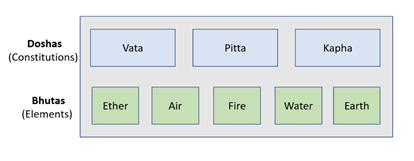The Ayurvedic clock.
Growing up in Pakistan, I was uniquely blessed to be living in a household with not just one but both of my grandmothers.
Though not witnessed often in the West, it is fairly common to find multigenerational households in Southeast Asia, being raised with the cultural tradition of being responsible for, and taking care of, aging parents.
This gave me the tremendous opportunity to learn from their wisdom, rituals that had been passed down across generations. As a child, though, I have to admit, I was not terribly excited about sharing a bedroom with my grandmother, which meant having to turn my lights off before 11 p.m. and being awakened by her early morning routine at the crack of dawn.
Now, however, as I age and the more I read about Ayurveda, and its holistic rituals for self-care, the more I am in awe of my grandmothers and their knowledge, which saw them living a full life well into their 90s.
I look back fondly at the memories of being treated to drops of freshly-squeezed ginger juice mixed with honey to treat a bad cough, a soothing glass of hot milk with turmeric and cardamom for healing, or the habit of rising with the sun to pray, meditate, and reap the benefits of some quiet solitude.
Ayurveda has steadily been gaining in popularity, demand, and research the world over, closely following in the footsteps of what is often referred to as its sister science, yoga. However, as with yoga, where the misguided focus has mainly been on perfecting the asanas (poses), Ayurveda has been getting the same treatment: the difference being, with yoga, the aim may have been for the perfect Instagram post, that too in Lululemon yoga pants, and with Ayurveda, it’s probably a post with a trendy turmeric latte from Starbucks instead!
So, what does Ayurveda really mean? It isn’t simply about introducing certain natural herbs and spices or organic food into our diet. Rather, it is about understanding and honouring the subtle connections between all of nature—the realisation that we are all interconnected with each other and, in fact, the whole universe. This is the fundamental principle of Ayurveda, known as the Macrocosm-microcosm continuum theory: as is the atom, so is the universe. What this means is that any shift in nature causes us to change, but also, that our actions can also strongly impact nature.
Ayurveda defines nature as being composed of five elements or bhutas: ether (space), air, fire, water, and earth. These elements are found in everything, us included, and we need them all to survive. However, they are expressed differently and in varying degrees in each of us, making every thing and being unique.
The three doshas, or the Ayurvedic constitutions, defining a certain mind-body type, are a combination of two of the five elements. Similar to the elements, while everyone has traits of all three doshas, we all have a predominant mind-body type, which predisposes us to certain dominant traits and illnesses.
So, in a nutshell:

The Ayurvedic clock
Every dosha is responsible for different physiological functions, different organs, and systems, and they all have their peaks at different times during the 24-hour daily cycle. Knowing which dosha corresponds to a specific time of day can help us locate potential imbalances and, at the same time, maximise the body’s ability to complete tasks.
The Ayurvedic clock is divided into six four-hour periods:
6-10 a.m. The kapha dosha, consisting of water and earth elements, is strongest early in the morning. Due to the strong earth qualities, one is most grounded at this time, making it the best time for exercise and doing projects that require endurance, such as dense, challenging reading, or going for a long bike ride, or run.
It is important to note that the later you wake up in this period, the groggier you will feel. For example, if you sleep in on a weekend well past your normal wake up time, you will invariably feel tired, not because of too much sleep but because of excess kapha and the accumulation of heavy energy.
10 a.m.-2 p.m. No surprise here that pitta, comprising of fire and water elements, is at its prime with the peak of the sun. This is when our agni, or digestion, burns brightest, making it the best time to have our heaviest meal. Pitta also happens to rule the analytical mind, so tasks requiring clear focus such as bookkeeping or studying for an exam are ideally suited for this period too.
However, combining these activities, a common one being eating while you work, leaves one more agitated than balanced. So, a note of caution, instead of multitasking to save time, having your meal on the go, or while sitting at your laptop, be mindful and take a proper break to have lunch before going back to work.
2-6 p.m. Finally, the third dosha, vata, consisting of the air and ether elements, governs the nervous system, which means you may feel a spike in your fight-or-flight response. This, in turn, can manifest itself as a peak in your creativity, with it being primed for brainstorming, innovative ideas, creative designs, or marketing campaigns.
Too much vata overload, however, can leave one feeling depleted. Take good care, though; when you feel you need a boost of energy, don’t give in to the temptation for coffee or a sugary snack. Instead, go for a short walk, meditate, or take a short break.
6-10 p.m. The cycle then repeats itself again in the evening, returning to kapha. Since it represents strength and endurance, this period is the second choice (the first choice being the same period in the morning) for physical exercise and hygiene. However, focus on exercising early on during this period as the body gradually begins to wind down for sleep. Digestion also slows down, which is why we should have dinner early and keep it light.
Coming to the tricky one, one should avoid stimulating activities past 8 p.m., especially electronic devices that emit blue light, in particular cell phones, tablets, and laptops. Going on the screens tricks the mind into believing it is still daytime and messes up the sleep cycle.
10 p.m.-2 a.m. The middle of the night, just like the middle of the day, is governed by pitta. The fire at this time is used for detoxification, liver function, revitalisation of skin, blood cleansing, and mental restoration. There is a lot of misuse of the pitta energy, with night owls working late into the night or staying up with friends.
This time of night is meant for the organs and body to restore and recover while asleep. Choosing to stay awake too far past 10 p.m. would divert energy away from the important restoration period of our organs.
2-6 a.m. The early morning period is ruled by vata, the light and mobile period when both dreams and the mind are most active. This timeframe is considered to be the most auspicious hour, best suited for spiritual practices, such as prayer or meditation. Members of many religious communities, from Muslims to Jews to Buddhists, wake before sunrise precisely for this reason.
Personally, I have watched my mother do the same, amazed at her discipline, which has seen her follow this early morning ritual undeterred—even a life-threatening illness couldn’t keep her away. She has played a pivotal role in making me realise the importance of being consistent with one’s own schedule and with that of the natural cycles.
So, now I too try to harmonise my routine to the natural Ayurvedic and circadian clocks in order to optimise the functioning of my body, mind, and soul.
Here I am writing after my early morning prayer, exercise, and meditation session—I cannot emphasize enough how this change of routine has affected my state of well-being!
*I will elaborate more on the circadian cycle in my next article.
~











Read 56 comments and reply